

Op-Ed: Is it Time for the U.S. Navy to Build the Drone Carrier Warship?
As the pentagon and congress grapple on determining what to build to meet the “500-ship u.s. navy goal,” a couple of years-old ideas and artist renderings may lead to a more flexible future for the u.s. navy’s global operations..
Peter Ong 26 Apr 2021
BAE Systems' UXV and Naval Group’s “Ocean Avenger” are Potential Candidates
What is needed is a hybrid warship that can deploy all kinds of unmanned systems, provide long-range air and ship fire support for the land forces, address peer nation challenges, remain present and available daily, and multitask in many warfare areas.
What ship can accomplish all this? The BAE Systems’ 8,000-ton Unmanned Experimental Vessel (UXV)* and Naval Group’s 4,000-ton “Ocean Avenger” Drone Carrier Warship designs are concept ships that were rendered and were never built even though the Littoral Combat Ship (LCS) and DDG 1000 ( Zumwalt destroyers) were. (*UXV is not an unmanned warship, but is crewed by sailors that launch and retrieve unmanned air, surface, and subsurface drone systems).
As the U.S. Navy and U.S. Marine Corps test unmanned air, sea, and underwater drones at the U.S. Pacific Fleet’s Unmanned Integrated Battle Problem (UxS IBP) 21 (held in late April, 2021), no current U.S. warship in service is designed to actually carry, transport, handle, control, launch and retrieve, and maintain all three environmental types of drones. A few of these drones have been used and launched by a few fielded warships; however, not one U.S. warship design exists to launch all three types of drones in significant numbers for combat, recon, patrol, and maritime operations, let alone detach itself for amphibious duties and assault. The Expeditionary Sea Base (ESB) is relatively unarmed, and the LPD-17 and LHA amphibious assault ships lack VLS missile tubes and long-range gunfire support.
Is the answer to the U.S. Navy’s future unmanned system fleet already design and rendered? Naval News explores two Drone Carrier Warship designs (half aircraft carrier/half combat warship) in this Opinion-Editorial Analysis.
Presenting:
- The Kratos XQ-58A “Valkyrie” Unmanned Combat Aircraft (UCAV) drone
- The MQ-8 “Fire Scout” Unmanned Vertical Take-off and Landing (VTOL) rotorcraft drone
- The BAE Systems 8,000-ton UXV Drone Carrier Warship
- The Naval Group Class-04-03 4,000-ton “Ocean Avenger” trimaran Drone Carrier Warship
“It starts and ends with the map, and I don’t mean that in an abstract sense. I mean these are massive distances that we’re talking about in INDO-PACOM. We can’t commute to work. We’re just not going to be able to commute to work if things heat up, so we’re going to be relying in Allies and partners to be forward-deployed and have that day-to-day presence in the region.” Representative Mike Gallagher (R-Wisconsin). Co-Chair, House National Security Caucus and Member, House Armed Services Seapower and Projection Forces Subcommittee at USNI/CSIS “The Future of the U.S. Navy” virtual webinar, March 2021
By 2021, the U.S. Navy has implemented a ship building plan dating back to designs created in the 1990s and 2000s, as seen in this “Warships of Tomorrow” Popular Science article. The Littoral Combat Ship (LCS) and the stealthy Zumwalt destroyer (DDG 1000) were built to strikingly remarkable resemblances to the artist’s renderings. The CG(X) was discussed by the U.S. Navy, shipbuilding industry, and the Think Tanks, but no mention was made of the UXV Drone Carrier, when at that time in mid-2000s, Artificial Intelligence and drones were just getting started or budding. Is it time for the U.S. Navy to build the UXV Drone Carrier Warship to relieve the U.S. Naval Fleet Forces of using the overtaxed Carrier Strike Groups and Amphibious Ready Groups?
According to 3Wktr.com, “The USS Nimitz aircraft carrier is returning to San Diego Friday afternoon. The ship’s homeport is in Washington State. The crew has been deployed for 321 days. This deployment length is the longest since the Vietnam War.” That statement was dated February 26, 2021.
321 days is ten months, four more months than the usual half-year (or six-month overseas ship deployment). USS Nimitz , the longest aircraft carrier deployment in history, shows how overstressed and “in-demand” the U.S. Navy’s (USN) aircraft carriers are around the world.
A U.S. Navy Landing Helicopter Assault (LHA) or Landing Helicopter Dock (LHD) can deploy as a standard light aircraft carrier (standard is six United States Marine Corps (USMC) F-35Bs on board), or as a “Lightning Carrier,” equipped with anywhere from 10 to 20+ F-35Bs as part of an Amphibious Ready Group. However, China and the U.S. Navy and Marine Corps know that the range of the F-35B (669 nmi (770 mi, 1,239 km) on internal fuel) places it well within the range of Anti-Ship ballistic missiles such as the Chinese DF-21 fired from a Transporter Erector Launcher (TEL) truck. The People’s Liberation Army’s (PLA) DF-21 has a described range of 1,100 miles (1,770 km). As of mid-2021, existing American manned naval aircraft will always be outranged by the Chinese TEL Anti-Ship missiles as evident in the graphics below.

A Checkered Reality: Issues with the U.S. Navy’s DDG 1000s and the Littoral Combat Ships
Although outside the scope of this Opinion-Editorial Analysis, readers can research how the “Warships of Tomorrow” plan kind of semi-failed to meet actual U.S. Navy expectations once these two ships were actually built and fielded. Briefly:
- The U.S. Navy didn’t use the U.S. Army and NATO-standard 155mm cannon and shells as the foundational basis in the DDG 1000s’ Armored Gun Systems (AGS), thus requiring a specialized AGS GPS extended-range round that cost upwards of $800,000 each. The U.S. Navy has since canceled the AGS shell program and the AGSs currently have no shells to fire. 2021 plans might call for the AGSs’ removal to accommodate large Hypersonic VLS missile cells although this has been unconfirmed.
- The LCSs are only built to Level One survivability and are undergoing upgrades to improve their combat survivability and lethality, including the incorporation of eight launchers of the stealthy 100-nautical mile Naval Strike Missile, adding electronic countermeasures, missile decoys, and adding additional steel.
- The LCSs’ Mission Modules, once considered swappable Plug-and-Play modules, take too long to actually swap out. Hence the U.S. Navy decided to keep the Modules in place with some LCSs carrying Mine Countermeasure Modules (MCM), others Anti-Submarine Warfare (ASW) Modules, and others Anti-Surface Warfare (ASuW) Modules.
- Due to weapon and lethality issues, the DDG 1000s (no functioning 155mm AGSs as of 2021 to provide shore bombardment for the U.S. Marines) and LCSs (have no VLS cells for medium to long-range Anti-Air and Anti-Surface Warfare missiles) somewhat fail in their “Deterrence values” as warships.
- Railguns, lasers, and all those “high-tech (energy consuming) researched and developed weapons” didn’t really mature well enough by mid-2021 to be actually implemented into the DDG 1000s and LCSs on a cost-effective basis.
- The time required for an LCS to sweep for mines actually takes longer than an Avenger -class MCM ship because the LCSs relies on a variety of drones that perform single functions. These drones cannot multitask to accomplish the mission of scanning, detecting, locating, and neutralizing the mines so each sweeping mission requires the launching and retrieval of a separate onboard LCS drone to accomplish these tasks.
The U.S. Navy is currently working to remedy these deficiencies by creating Task Forces and studies to address these issues, as stated in the Surface Navy Association 2020 and 2021 Virtual Symposiums.
A New Kind of Warship from a Past Idea: The BAE Systems UXV and the Naval Group “Ocean Avenger”
For speculative opinions and analysis, let’s explore the UCAVs, UAVs, and the Drone Carrier Warship . We’ll refer to the BAE Systems UXV and the Naval Group “Ocean Avenger” as a “Carrier Warship” because they carry VLS cells and a 155mm cannon, so it’s not a true carrier such as the CVN and LHA “flattops.”
Enter the Kratos XQ-58A “Valkyrie” Unmanned Combat Air Vehicle (UCAV)
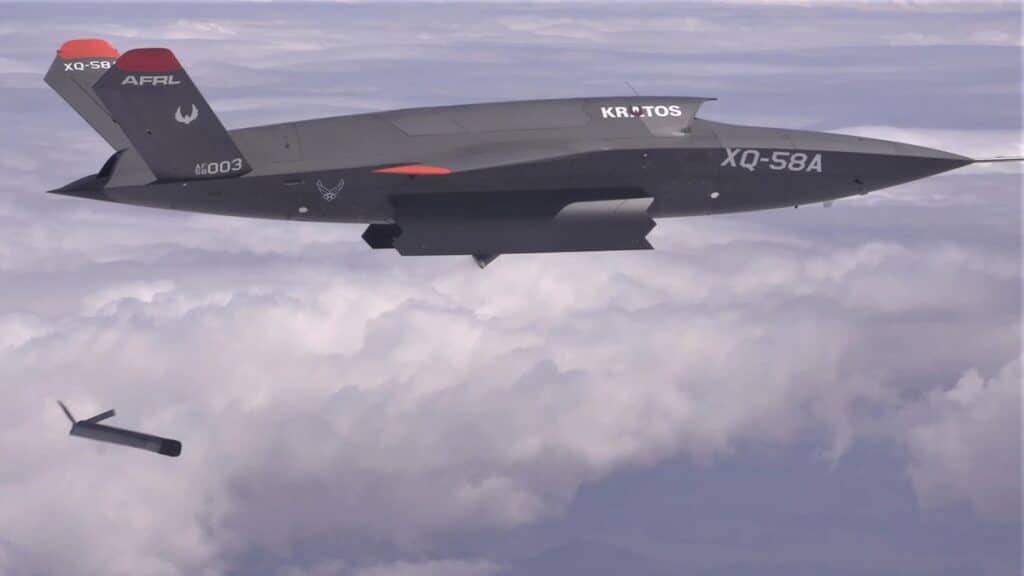
The U.S.-made Kratos®’s XQ-58A “Valkyrie” UCAV’s range is unprecedented, flying for 2,128 nmi (2,449 mi, 3,941 km) one way, or 1,275 miles to and from for a round trip, placing it just outside of the PLA’s DF-21C’s range (1,700 km/1,056 miles for the DF-21C and 3,000 km or 1,864 miles for the DF-21D).
The XQ-58A, flying at Mach 0.85, is said to carry a payload of 544 kgs (1,199 pounds) in two internal weapons bays with four hardpoints each (eight hardpoints per XQ-58A). A 1,000-pound (450 kg) warhead can be the GPS-guided Joint Direct Attack Munition (JDAM) GBU-32 or GBU-35 bomb for the USN/USMC, or a Paveway laser guided bomb. An AGM-154 Joint Standoff Weapon (JSOW), weighing in at 483 kg to 497 kg (1,065 to 1,095 lb) and offering a low-altitude release of 22 km (12 nmi) to a high-altitude release of 130 km (70 nmi) might also work. Aerial refueling can be from the unmanned Boeing MQ-25 Stingray drone. Therefore, one Drone Carrier Warship can deliver a 1,000-pound warhead if one XQ-58A UCAV and one MQ-25 UAV refueling drone is embarked, or 2,000-pounds of explosives if two XQ-58As are onboard. More UCAVs embarked means more delivered aerial ordnance tonnage, respectively.
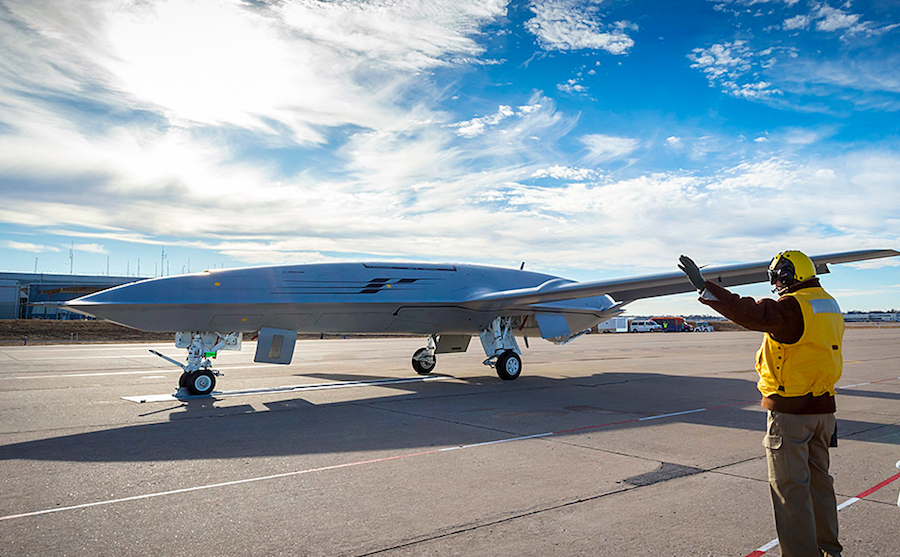
The cheap cost ($2 to $3 million each) of a XQ-58A “Valkyrie” means that these UCAVs are expendable. UCAV tactics and strategies still need to be fleshed out once placed into service; however, a Joint force of U.S. Navy, U.S. Marines, and U.S. Air Force XQ-58As, MQ-25 tankers, and other UAVs could mean an unmanned aerial air force could respond to a crisis before manned airpower reaches the battlespace.
And due to their long ranges, semi-stealthy XQ-58As, if deemed necessary, could be sent on one-way “suicide missions” just to reach and attack important targets 2,400+ miles away. Future stand-off ordnance in the 1,000-pound class could be developed to give the XQ-58A even more standoff fighting distance, as could small UAVs that are dropped from the internal weapons bay.
The XQ-58A could potentially act as a combat fighter also, able to take down enemy fighter combat patrols with volleys of long-range air-to-air missiles (AIM-120Ds), or as a Close Air Support UCAV armed with various precision guided small missiles and smart bombs. XQ-58As could be the U.S. Marine’s best loitering UCAV in the future, providing the constant “Armed Overwatch” support that stealthy manned USMC F-35Bs cannot due to the F-35Bs’ short range.
The Need for the Drone Carrier Warship for the U.S. Navy
“Advantage at Sea provides guidance to the Naval Service for the next decade to prevail across a continuum of competition—composed of interactions with other nations from cooperation to conflict. This strategy emphasizes the following five themes. We must fully leverage the complementary authorities and capabilities of the Naval Service to generate Integrated All-Domain Naval Power. We must strengthen our alliances and partnerships— our key strategic advantage in this long-term strategic competition—and achieve unity of effort. We must operate more assertively to prevail in day-to-day competition as we uphold the rules-based order and deter our competitors from pursuing armed aggression. If our rivals escalate into conflict, becoming our adversaries, we must control the seas to deny their objectives, defeat their forces, protect our homeland, and defend our allies. And, we must boldly modernize the future naval force to maintain credible deterrence and preserve our advantage at sea.” Advantage at Sea, December 2020 – Signed by the Secretary of the U.S. Navy, Kenneth J. Braithwaite – Commandant of the U.S. Marine Corps, General David C. Berger – Chief of U.S. Naval Operations, Admiral Michael M. Gilday – Commandant of the U.S. Coast Guard, Admiral Karl L. Schultz
“We need to build a [future U.S.] Navy, but a Navy to do what? We need that type of vision and guidance. “The fact that the United States, they need to be there [around the world to counter peer nation influence]; we need to be in those places. We need to be the ones, or our allies, promoting that type of economic development or infrastructure in these countries [that China is influencing] because when we lose access, we’re not going to get access back. “Battle 2045: We have three things that we can do: A) We need to build more ships more quickly. B) We need to operate the ships that we have as efficiently as we can. C) And we need to not divest ourselves of platforms when they still have operational life left. …And I think that there are better models that we can deploy the Navy. I mean we get a lot more presence from our Forward Deployed Naval Forces, FDNF.” Representative Elaine Luria (D-Virginia) at USNI/CSIS “The Future of the U.S. Navy” virtual webinar, March 2021
“Less a technical one and more of a philosophical one of what is the actual deterrence value of an unmanned system? Are we going to get the same deterrence effect with a large unmanned surface vessel that we’re going to get with a frigate, or a destroyer, or a carrier? I doubt it. I just don’t think that we actually got to the philosophical value of deterrence that we need to understand what we’re doing with these unmanned systems and deterrence is what it’s all about.” Representative Mike Gallagher (R-Wisconsin) at USNI/CSIS “The Future of the U.S. Navy” virtual webinar, March 2021
The Drone Carrier Warship could remedy these doubts and act as the hybrid warship that the future U.S. Navy needs and desires—a vessel that can multitask in various warfare functions:
- Act as a command node, sheepdog, and provide “Armed Overwatch” for the LPD-17s and Light Amphibious Warships (LAWs) .
- Provide fire support via gunfire, missiles, potential Hypersonics, and long-range fires from VLS cells and a 155mm cannon independent of frigates, destroyers, and cruisers.
- Provide consistently available and present runways and landing pad for unmanned aircraft, rotorcraft, drones, and a floodable well deck for sea and subsurface vessels independent of carriers, warships, Sea bases, and amphibious ships.
- Provide expanded space for command, medical, dental, gym, facilities, food, Administration, maintenance, services, and logistics for the LAWs and small boats.
- Provide crisis response in-theater closer to hot-spots around the globe.
- Act as a Mothership vessel for future drones such as the MARTAC MANTAS T38 unmanned surface vessel (USV) .
- And be small and cheap enough to be built in large quantities.

Would the U.S. Navy and Congress be audacious enough to build the Drone Carrier Warship, considering how the Littoral Combat Ships (LCS) and the three expensive DDG 1000s were semi-successful or semi-failures depending on viewer perspectives? Can the U.S. Navy afford not to, considering how expensive it is to build, operate, maintain, refuel, and service a CVN nuclear powered aircraft carrier? (The USS Gerald R. Ford CVNs cost over $13 billion each, and that doesn’t include working out the “teething problems”). The Landing Helicopter Assaults (LHAs), such as the USS America , cost around $3.5 billion each, and are 844-feet (257 meters) long. The proposed UXV is smaller at 500-feet (152.4 meters), or the size of the U.S. Navy’s upcoming Constellation -class frigate (FFG-62), and that should be the U.S. Navy and Congress’s debate: Should the UXV or “Ocean Avenger” be built larger to at least LHA size to carry a larger unmanned air wing because the U.S Navy needs a dedicated UCAV Drone “flattop” Aircraft Carrier, not a half-flattop warship carrying a 155mm gun, VLS cells, and a few UCAVs? Or should the BAE UXV and Naval Group’s “Ocean Avenger” be built as the designed hybrid warship (4,000 to 8,000 tons respectively) carrying UCAVs, small and cheap enough so that the Navy can afford a larger fleet of these hybrid warships, perhaps numbering 20-40+ to aid in launching drone swarms and facilitate in Multi-Domain Operations (MDO), Distributed Maritime Operations (DMO), Distributed Lethality (DL), assist in C5ISR and sheepdog the Light Amphibious Warships (LAWs), and conduct multiple vectoring pincer movements in the open ocean? As Representative Elaine Luria (D-VA), Vice Chair, House Armed Services Committee & Member, Seapower and Projection Forces Subcommittee said at USNI/CSIS’s “The Future of the U.S. Navy,” held virtually in March 2021, “Surge didn’t make up for capacity” when it comes to having a U.S. Navy ship presence in INDO-PACOM and around the world. “Capacity”—the U.S. Navy needs to have a larger ship count to maintain consistent presence and “surging” one to three aircraft carriers in INDO-PACOM can’t make up the difference if the CVNs sail to other parts of the world’s oceans, leaving a void of U.S. ship and aircraft presence in the Anti-Access/Area Denial (A2/AD) area. The Drone Carrier Warship adds ship, drone, missile, cannon fire, and long-range aircraft presence, available daily.
The America- class LHAs won’t work as dedicated UCAV Drone Aircraft Carriers because the flight deck has to be cleared to launch the USMC F-35Bs that taxi to the stern and then use the entire length of the ship to get airborne (without a ski jump ramp), and the LHAs probably lack the maintenance facilities and space dedicated for UCAVs. The split-V runways of the UXVs allow for the launching of the UCAVs from one or both runways while one runway can be used to land UCAVs. Furthermore, deck space between the runways can be reserved for MQ-8 UAV rotorcraft and other vertical take-off and landing (VTOL) drones without getting in the way of UCAV launching and landing operations.

Another Drone Carrier Warship Variant: The Naval Group’s “Ocean Avenger”

At 4,000-tons, Naval Group’s Class-04-C3 “Ocean Avenger” trimaran (three hull) Drone Carrier Warship is half the displacement of the BAE UXV.
Similar in principle to the BAE UXV, the “Ocean Avenger” has two runways, but they’re not split-V, thanks to the three-hull tumblehome design, and instead has one runway per outboard hull. “Ocean Avenger,” however, does not have a floodable well deck for launching and retrieving unmanned surface vessels and underwater vessel drones (USVs and UUVs). This concept warship design uses conventional shafts and propellers, not high-powered waterjets as the LCSs.
“Ocean Avenger” does seem to possess Close-in Weapon Systems (CIWS) as the graphics show autocannons or CIWS can be positioned at the four corners of the ship for better all-around protection. “Ocean Avenger” also has a rotorcraft/UCAV hangar into the main superstructure behind the bridge, a design feature that the BAE UXV lacks. The Naval Group design does not appear to have any elevators to an interior hull hangar.
Unveiled by the French Shipbuilder during at the Euronaval 2018 show alongside other concept ships, “Ocean Avenger” carries the following:
- Multipurpose launchers (unspecified, but these can be 20-32 VLS cells)
- Electric railguns (most likely will be removed if built as this energy-hungry technology hasn’t matured enough to fit cost-effectively in small warship designs)
- Laser weapons (a possibility, depending in power consumption and laser miniaturization)
- Directed Energy Weapons (a possibility, depending in power consumption and laser miniaturization)
- Digital Combat Bridge (already exists in DDG 1000s with television screens and cameras acting as bridge wing lookouts)
- Antifouling (to combat marine organisms from growing on the hull)
- Software for seakeeping
- Composite materials (to reduce rust and for stealth radar low-signature purposes)
- UxV (for operating Unmanned Experimental Vessel or Vehicles)
- Integrated topside (all decks and systems are interconnected in the trimaran design)
- Hyperconnectivity
- Invisible ship (angled stealth characteristics, low profile and signatures)
- Cybersecurity (secure communications, networking, sensors, and datalinks to the drones and to outside forces)
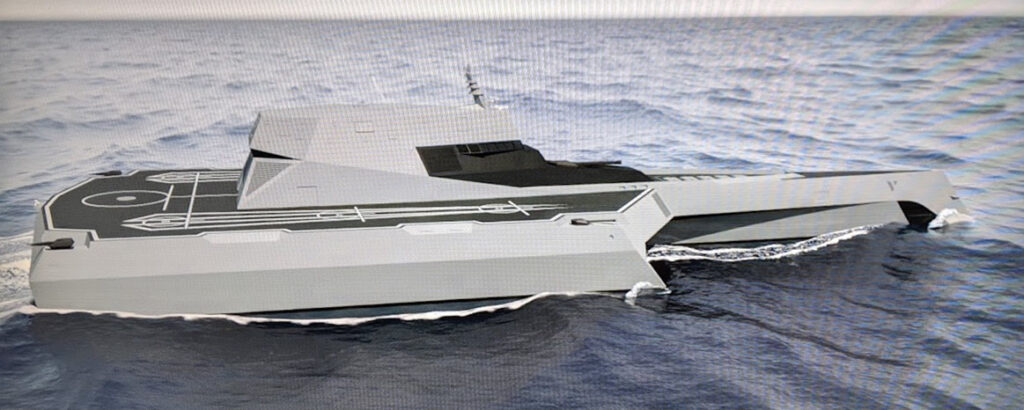
“Ocean Avenger’s” purpose is designed for:
- A Smart Ship (hardware and software that are compatible and “talk to” each other)
- Smart Naval Forces (Cooperative Engagement Capability (CEC) allows for the networking of several “Ocean Avengers” to act as a fleet)
- Smart Energy (regulated and monitored power sources and output)
- An Invulnerable ship (offensive/defensive armament, electronic warfare, missile jammers and decoys mean that “Ocean Avenger” does not require dedicated warship escorts as this Drone Carrier Warship can protect and defend itself).
- Smart Availability (with a small unmanned air force and the guns and missiles carried in its design, “Ocean Avenger” can be “on call” for flexible crisis response and U.S. Marine fire support that no other Navy warship can provide).
- Strike (Missions that require gun, missile, or air strikes)
- Point (Close-in defense from lasers, autocannons, (possible small railguns), machine guns, and Directed Energy Weapons)
- Seakeeping and survivability (the trimaran hull allows for outer protection from the main hull and Antifouling prolongs hull life)
- C5ISR (allows for the gathering, analysis, and interconnectivity to process data from all sensors and make important tactical battlespace decisions from commanders).
A Recipe for a Successful U.S. Navy Drone Carrier Warship
In order to create a successful Drone Carrier Warship, the U.S. Navy should implement these requirements dependent on vessel size, purpose, mission parameters, cost, deterrence, effectiveness, and future growth.
- MQ-8Bs and Cs outfitted to provide ASW, MCM, limited AAW, and ASuW for the USMC and the Navy. These MQ-8 packages could include sonobuoys , lightweight (miniature) torpedoes, 2.75” APKWS rockets, SPIKE NLOS/Longbow Hellfire missiles, COBRA MCM, gun pods, and Stinger Short-ranged Air-Defense (SHORAD) missiles.
- Optional: Adding unmanned tankers such as the Boeing MQ-25 to substitute for one or two XQ-58s to provide aerial tanking to manned and unmanned aircraft.
- A C5ISR and Combat Information Center room separate from the Drone Command Console Center (DC3).
- Close-in weapons systems (CIWS) in the form of 20mm Phalanx CIWS, RIM-116 Rolling Airframe Missiles (RAM), laser turrets, JQL/JAGM, or SeaRAM. Due to the UXV’s and “Ocean Avenger’s” stealthy design, these CIWS might not be incorporated if they affect stealth signature profile. If not, then the UXV and “Ocean Avenger” should have countermeasures in the form of Electronic Warfare and jamming, and drone swarms to fly out and intercept incoming missiles. (The triangular pedestal between the UXV’s two vertically angled superstructures could house crisscrossing RIM-116 RAM tubes angled outwards whereas JQL/JAGM launchers can be inserted between the RIM-116 tubes and fire from the pedestal’s top).
- A 20 or 32-cell “Strike-Length” VLS that fires ASROC, Tomahawk, Evolved Sea Sparrow Missiles (ESSM), Standard missiles, Naval Strike Missiles, and Long-ranged Anti-Ship Missiles (LRASMs). Some UXVs and “Ocean Avengers” could also be designed with larger VLS cells for Hypersonic missiles for a High-Low cost VLS cell missile mix.
- A U.S. Army’s M1299 155mm Extended Ranged Cannon Artillery (ERCA) howitzer in turret, corrosion protected, and using the U.S. Army’s autoloader and automated shell and powder magazine to provide precision shore bombardment. The key is to use NATO Army-standard 155mm shells.
- A smart 155mm autoloading magazine that can take a variety of NATO-standard 155mm shells, including smoke, White Phosphorus, High-Explosive Dual Purpose, GPS rocket-assisted projectiles (RAP), Armor-piercing rounds, GPS RAP Glider warhead shells, illumination, canister shot, flechette, etc.;
- A Nixie Anti-torpedo system or future Anti-torpedo torpedo launchers.
- A well deck for launching RHIBs, unmanned surface vessels, unmanned underwater vessels, remote operated vehicles, swimmers and divers, and small hovercrafts for tactical firepower, rescue, recovery, transport, C4ISR, patrols, medical evacuation, and logistics. (The Naval Group design lacks a well deck and one doesn’t need to be designed in). An adequate self-protective detail of U.S. Marines for shipboard security.
- Interior hardened armories for smart missiles, bombs, mines, miniature torpedoes, and air-to-air weapons with rapid-elevators to the flight deck and to the well deck.
- A gallery and Mess Hall, additional berthing, small gym, dental, barber, ship’s shop, library, and a medical bay to provide hot meals and expanded care for the LAW-embarked Marines. The UXV can act as a temporary “Marine Mothership” to cruising LAWs in the INDO-PACOM region that lend one-third (25 Marines) out of the LAW’s 75 Marines for a temporary hot meal and additional care per rotating Rest and Relief shift during the LAWs 30-day patrols of the INDO-PACOM region. This will help boost Marine morale and health, and harks back to the days of World War Two where the UXV acts as a tender compared to using the larger, complex, scarce and expensive LPD-17s.
- Flight Deck Operations Room facing the stern of the ship and acting as Air Traffic Controller.
- Lifeboats and rescue boats;
- An interior hardened, separate, and secure Drone Console Command Center (DC3) room with 20-30 individual consoles to control more than the four aerial drones embarked aboard the UXV. DC3 functions as a hardened Command node center to coordinate drone swarms on sea, below the water, and in the air. The DC3 should be a separate room from the CIC, perhaps as a smaller second story room overlooking the main CIC as in the DDG 1000s.
- A sonar dome at the bow and optional towed sonar array.
- Optional berthing and amenities for SEALs and special forces detachments;
- The optional Moon Pool at the belly of the ship could be deleted because the Moon Pool might affect hull integrity and prove too complex compared to a standard stern well deck.
- Interior hangar and workshops for UCAV and UAV maintenance (can the hangar hide a USMC HiMARS, brought up to the flight deck to fire land attack or Anti-ship missiles?);
- Elevators to and from the hangar to the flight deck;
- Proven UCAV arresting gear (and if necessary, EMALs catapults);
- Chaff and Anti-Missile decoys for the UXV;
- Machine guns mounts along the perimeter for self-protection, either manual or remotely operated;
- Steel and Kevlar protection over vital spaces and compartments;
- A XQ-58A jet engine test stand venting jet exhaust to the outside similar to the CVN;
- Fire suppression and armored blast protection for the drone aviation fuel and ordnance;
- Nuclear, Biological, and Chemical decontamination features for personnel, Marines, flight deck, and drones;
- Incorporation of robotics and automation systems;
- Proven engines and generators for future growth;
- 28-30+ kts speed (preferably over 30+ kts);
- Aircraft fire extinguishing agents and associated vehicles;
- Small Mission Module Bay by the well deck for cargo and unmanned surface and subsurface drone modifications and stacking of additional inflatable boats;
- Removal portals and hatches for lookouts and Close-Quarters Protection (similar to the DDG 1000s);
- Exterior cameras and telescopes for situational awareness in a stealth superstructure;
- A garage behind the aft superstructure to house the UAV firefighting vehicles, tow trucks, carts, cranes, and forklifts (not shown in the UXV design).
- One or two Mk 38 MOD 3 25mm or Mk46 30mm autocannon turret(s) over the optional UXV garage (similar to the DDG 1000 setup) for rear area protection.
- Some Drone Carrier Warship hulls could carry a separate and dedicated Air Warfare Officer Command Center to complement the aging Ticonderoga -class cruisers.
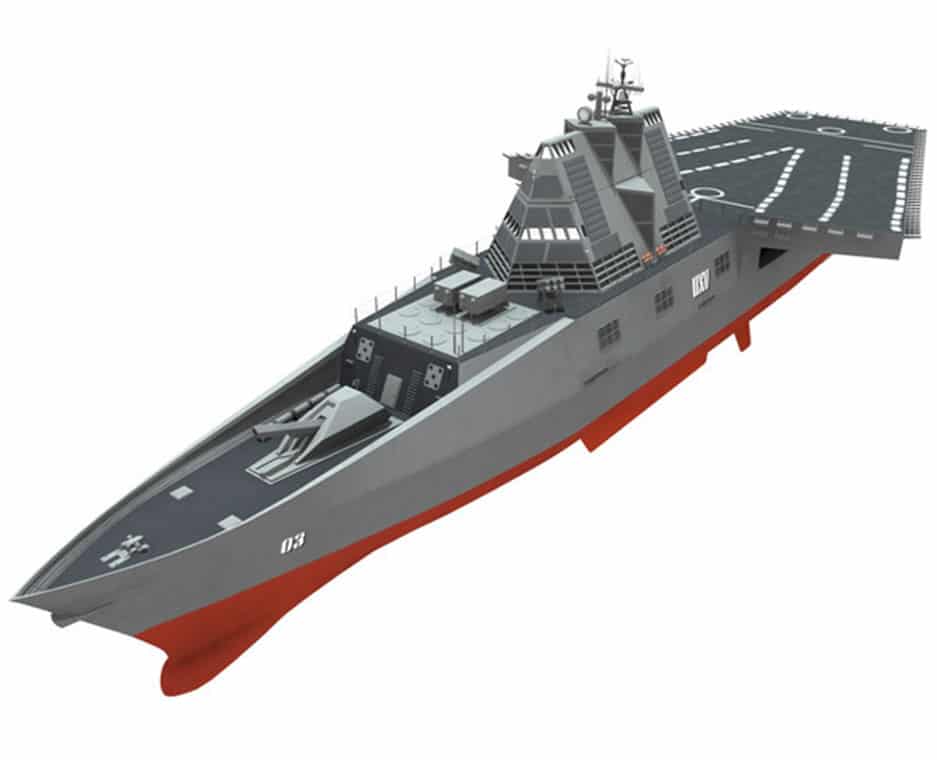
The Drone Carrier Warship design could be used by NATO and allied RIMPAC navies with the host nation providing their own indigenous UCAVs, drones, unmanned vessels, ship weapons, and design modifications. This would alleviate the need and pursuit for large expensive “flattop” carriers and air wings that few foreign navies are able and willing to fund, build, invest, operate, and maintain.
Drone Carrier Warship Scenario:
A Drone Carrier Warship (DCW) stationed somewhere in the western Pacific Ocean region can launch two stealthy XQ-58As from 2,300 miles away, have them drop their ordnance over land, and then fly and land on a DCW sailing somewhere in the Indian Ocean while that Indian Ocean DCW does the same thing, having its two XQ-58As fly towards their land targets and then fly out to land on the Pacific Ocean DCW. (We will just assume that each DCW carries two available XQ-58s. If the each DCW carries four UCAVs, the aerial firepower will be even greater).
Now imagine a U.S. Navy Task Force comprising of four DCWs sailing in the Pacific and four DCWs sailing in the Indian Ocean, each DCW carrying two XQ-58As. Thus, eight DCWs provide a total of sixteen XQ-58As able to deliver sixteen 1,000-pound bombs against sixteen different land targets without the need for LHAs’ or CVNs’ airpower. Or, sixteen XQ-58As, each one having eight internal hardpoints, can attack 80 separate targets with 80 Small Diameter Bombs (SDB II, also known as the GBU-53/B “Stormbreaker”) since each GBU-53 weighs 204 lb (93 kg) and the XQ-58A can carry 544 kgs (1,199 pounds), or five SDB IIs in each XQ-58A (1,020 lbs total) with about 179 lb to spare. The GBU-53 has a decent standoff range of 69 miles (110 km) against stationary targets and 45 miles (72 km) against moving targets. (If the eight DCWs carry four XQ-58s each, that would be 160 SDB IIs, or thirty-two 1,000-pound JDAMs that can be independently targeted. The flight deck may be able to house more UCAVs at the expense of UAV rotorcrafts at their landing spots).
This mini-UCAV DCW naval air force could make a striking difference in future naval operations, well-protected by AEGIS DDG-51 destroyers, FFG(X) frigates, and ASW rotorcraft, not to mention having VLS cells for its own long-rang defense and offensive attack.
If the DCW warship design functions as advertised, and the DCW uses the modified corrosion-resistant U.S. Army’s M1299 155mm ERCA cannon that can fire 10 rounds-per-minute with an autoloader, four DCWs working together can fire 40 Extended-range GPS-guided 155mm shells per minute from 43-62 miles (70-100 km) away and provide the explosive precision shore bombardment punch for fraction of the cost of one custom $800,000 shell that was canceled for the DDG 1000 Zumwalts . The 155mm ERCA cannon onboard the DCW might be able to substitute for the lack of USMC M1A1 tank firepower during amphibious assaults.
A new large logistics tender ship would sail with each Drone Carrier Warship Ocean Task Force and the tender’s large towering deck crane would replace any DCW’s XQ-58As that get shot down because the XQ-58A can fit inside a standard-sized shipping container for transport . The XQ-58As stored in shipping containers could even be lifted onto the decks of the DCWs if the U.S. Navy decides to acquire the new manned CH-53K “King Stallion” as a vertical replenishment helicopter.
Again, note that this imaginary scenario is for a DCW in the 500-foot class (152.4 meters), and not for a Drone “flattop” Carrier around 800 (243 meters) to 1,000 feet (304 meters) long with interior hull aircraft hangars and elevators. If the U.S. Navy decided to build a dedicated Drone Carrier that loosely resembles the LHA or CVNs for a much larger UCAV and UAV air wing, then the DCW split-V and trimaran runway warship design would not qualify.
Conclusion: UXVs and/or “Ocean Avenger” Could Aid the Future U.S. Navy and Deter by Multitasking
The deterrence value of a High-Low mix of Drone Carrier Warships (if both the UXV and “Ocean Avenger were built) would be dramatic in the INDO-PACOM region and would provide the unmanned systems, the 155mm AGS shore battery fire support, the missile protection, and the Anti-Mine and Anti-Submarine systems that the DDG 1000s and LCSs have partially failed to deliver. The DCW could be the de facto ship that bridges and solves many of the U.S. Navy’s issues revolving around the lack of long-range gunfire support for the U.S. Marines and the lack of long-range offensive armament on the poorly-armed LAWs, LPDs, and LCSs.
By providing consistently available overwatch in the air, on the water, and below the sea from unmanned systems, moderately-armed and faster DCWs would make the battlespace much safer for the deployments of the poorly-armed and slow Light Amphibious Warships (LAWs) compared to using the poor-armed LPD-17s and the unarmed Expeditionary Sea Base (ESBs) as Mothership LAW sheepdogs. The Drone Carrier Warship’s VLS cells and the 155mm ERCA would defeat targets that threaten the U.S. Marines as they come ashore. Currently, the U.S. Navy lacks a plan as to who, what, where, and how to provide offensive and defensive support to the poorly-armed LAWs sailing in the INDO-PACOM region outside of the customary expensive U.S. Navy warships. Having two or more XQ-58 UCAVs on station daily could lessen the need for LHA F-35Bs and CVN F-35Cs as the central aerial system used for A2/AD breaching, keeping the expensive and scarce stealthy F-35s further back from the fight. More XQ-58As and/or MQ-8s can be carried onboard and launched in times of crisis, and the DCW might even be able to launch and land the two-seat propeller “Armed Overwatch” Light Attack Plane that the U.S. Special Operations Command wants, or operate U.S. Marine or special forces helicopters and tiltrotors.
For roughly the size of a U.S. Navy Constellation -class FFG-62 FREMM-modified frigate , the Drone Carrier Warship can offer a versatile firepower mix unapparelled and unmatched in a U.S. Navy warship design. Able to operate independently or in groups, the UXVs will have cruising staying power and perform as “Crisis Responders” instead of as dedicated “flattops” responding to global crises as the LHAs and CVNs often do, these flattops having to sail around the world on deployment.
U.S. Navy Drone Carrier Warships would act as the Motherships for many drone systems in the INDO-PACOM region and around the world, able to counter drone swarms, check militia fishing boats, provide “Armed Overwatch,” conduct limited Intelligence, Surveillance, Reconnaissance (ISR), perform limited Airborne Warning and Command, sheepdog the smaller U.S. Navy ships and boats, escort convoys, and provide the muscle and teeth outside of the CVNs and LHA Strike Groups that have to sail around the world on deployments.
Drone mixes and future systems will be left to the imaginations of the Fleet Force Commanders and Naval strategists, but they will have a ship that can transport, launch, command, gather data, analyze, and retrieve these remote-piloted systems, and sit in a warship that can protect itself.
These hybrid warship designs, even dating back years to decades, are unique in that they have two unimpeded runways for UCAV operations. The drone software, A.I., 155mm ERCA; autoloading, robotics, and automation; and Hypersonic technology is now maturing in the 2020s. The U.S. Navy could be seeing their future warship force by reengaging some past concepts and revising some artist’s renderings that date back many years.
The time for the Drone Carrier Warship concept to become a reality may be in the 2020s and the U.S. Navy and Marine Corps should definitely consider studying and perhaps revitalizing the BAE UXV split-V or the Naval Group two-runway trimaran hybrid warship concepts.

Related Articles

Portuguese Navy Develops “Disruptive” Coastal Patrol Vessels
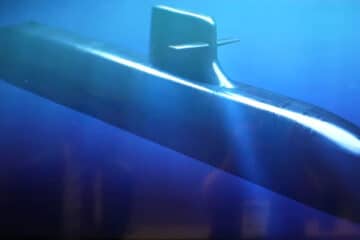
The Netherlands Select Naval Group for its New Submarines
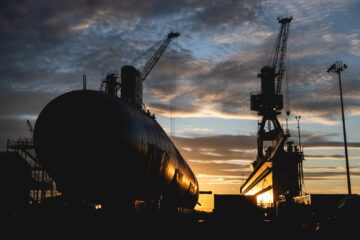
US Navy Requests Lowest Number of Ships To Date for FY 2025

Times of San Diego
Local News and Opinion for San Diego
Future USS Canberra Will be First Navy Warship Commissioned in Australia
Share this:
- Click to share on Twitter (Opens in new window)
- Click to share on Facebook (Opens in new window)
- Click to share on Reddit (Opens in new window)
- Click to share on Pinterest (Opens in new window)
- Click to email a link to a friend (Opens in new window)
- Click to print (Opens in new window)

A littoral combat ship bound for Naval Base San Diego will be commissioned in Australia, marking the first international commissioning and deepening ties between two Pacific-facing democracies, the Navy announced.
The future USS Canberra, the 16th trimaran variant of the littoral class, will soon head from San Diego to Sydney for its commissioning on July 22 and then officially join the fleet.
“I can think of no better way to signify our enduring partnership with Australia than celebrating the newest U.S. Navy warship named for Australia’s capital city, and commissioning her in Royal Australian Navy Fleet Base East surrounded by many of the Australian ships we have worked alongside for years,” said Navy Secretary Carlos Del Toro.
It will be the second U.S. ship to bear the name. The first was a heavy cruiser named in honor of HMAS Canberra, which was heavily damaged and scuttled while protecting U.S. Marines fighting ashore during the Battle of Savo Island in 1942.
Australian Chief of Navy, Vice Adm. Mark Hammond, said the commissioning encapsulates both the depth of the historical ties, and the modern day partnership between the Royal Australian Navy and the U.S. Navy.
“This is a unique demonstration of respect by the U.S. for the officers and sailors of the Royal Australian Navy,” Hammond said. “As we look to the future, the strength of our partnership remains a cornerstone of a secure, stable, free and open Indo-Pacific Region.”
The ship was built in Mobile, Alabama, by Austal USA , the U.S. unit of an Australian company that also has a growing presence in San Diego.
The new ship is 418 feet in length, armed with guns, missiles and helicopters, and can reach speeds of over 50 mph. The littoral ships are being built in two variants, with all vessels of the trimaran version based in San Diego.
Chris Jennewein
Chris Jennewein is Editor & Publisher of Times of San Diego. More by Chris Jennewein
Switch language:

Triton Trimaran
The Triton trimaran research ship was a technology demonstrator ship for the Royal Navy's future surface combatant (FSC)
Vosper Thornycroft
Gardline Marine Sciences
44 (14 civilian crew + 30 officers)
Gross Tonnage
Diesel electric propulsion
2 × Paxman 12VP185 2MW diesel engines
1 × five-bladed composite propeller
2 × 350kW electric side thrusters
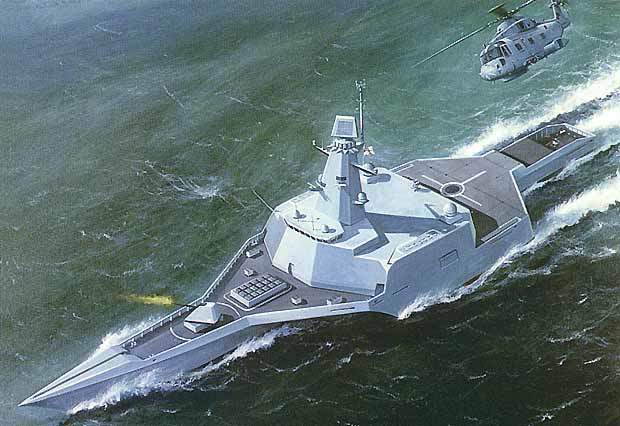
The Triton trimaran research ship was a technology demonstrator ship for the Royal Navy’s future surface combatant (FSC) frigate requirement, due to enter service from 2013 and replace the Type 23 frigates. Triton is the world’s largest motor powered trimaran (triple-hulled) vessel, with a length of 90m and beam of 22m. QinetiQ (formerly DERA, the Defence Evaluation and Research Agency) funded the design and manufacture of the vessel, to be used to quantify the structural and seakeeping performance of the trimaran.
In August 1998, the UK Ministry of Defence (MoD) awarded a contract to Vosper Thornycroft to construct the Trimaran, called RV (research vessel) Triton. The vessel was launched in May 2000 and delivered in August 2000. Triton then began a two-year risk reduction trials programme for the UK MoD and the US Department of Defense.
Recommended White Papers
Enhancing Naval Fleet Efficiency
Naval technology excellence awards report 2023, recommended buyers guides.
Command and control systems and components for the naval defence industry
Military communications systems and equipment suppliers for the naval defence industry.
Following completion of the trials programme, Triton has been used as a trials platform for other QinetiQ technologies including the composite propeller.
In January 2005, Triton was sold to Gardline Marine Sciences, a UK company based in Great Yarmouth, Norfolk. Triton was used for hydrographic survey work for the civil hydrography programme (CHP) on behalf of the Maritime and Coastguard Agency (MCA). The vessel was fitted with a sensor suite which includes the Kongsberg Simrad EM1002 multibeam echo-sounder, a GPS attitude / heading system, surface navigation and ultra-short baseline sub-surface acoustic tracking system, Gardline Voyager5 integrated survey system and Caris post-processing system.
Triton was the launch vessel for the QinetiQ 1 programme to break the world altitude record for a manned balloon. The target altitude of 25 miles (132,000ft) would take the two pilots into the stratosphere.
The giant helium-filled balloon had a nine-acre area and was as high as the Empire State Building. An attempt on the record, in September 2003, was aborted after an 8m tear appeared in the helium balloon envelope during launch.
Triton has become a patrol vessel since it was chartered to the Australian Customs Service in December 2006. It has been deployed in northern waters of Australia to work along with other customs and Royal Australian Navy patrol boats.
The vessel has been modified to provide additional accommodation and also fitted with two 0.50-calibre machine guns to perform patrol operations. The vessel is also equipped with two 7.3m high-speed rigid hull inflatable boats (RHIBs). The boats are powered by Evinrude outboard motors and have the range of 200nm at 30kt speed. Following the modifications in the UK and Singapore shipyards, it was delivered to the customs in January 2007.
Trimaran hullform trials programme
The trials programme to determine the suitability of the trimaran hullform began in October 2000 and included operations in a variety of sea states and at differing speeds. Triton successfully completed replenishment at sea (RAS), structural loading and seakeeping trials, landing and take-off trials by a Royal Navy Lynx mk8 helicopter, towing operations and small boat launch and recovery. It also took part in trials with the US Coastguard. The trials were concluded in September 2002, successfully proving that the design could operate in exactly the same way as an equivalent mono-hull vessel.
Advantages of trimaran design
The advantages of a trimaran hullform over conventional mono-hulls are thought to be: reduced costs, reduced signature, significantly less drag increased speed, increased length, giving greater stability, and more room for the upper deck, which could be used for the flight deck as well as hangars for helicopters and extra armaments.
Applications
The Trimaran development has been driven by frigate type applications. Concept studies have been carried out for other roles including offshore patrol, concept studies for future vessel development – for example, the mini landing platform helicopter ship (mini LPH), fast roll-on / roll-off rapid deployment support ships, and air-capable stealth vessels.
Demonstrator vessel contruction
The demonstrator is built at two thirds the size of a full-scale warship and although not armed it is capable of carrying containerised Naval military systems at sea. The 90m length of the Trimaran demonstrator meets the structural constraints of the ship’s plating and longitudinal stiffening. The main hulls and bridge deck are of steel construction.
A comprehensive ballast system accommodates trials in various operating conditions. The structure will accept containerised trials equipment. The flight deck strength is to be rated to accommodate a Lynx helicopter and be capable of operating unmanned aerial vehicles.
Provision is made for future electric propulsion trials involving the installation of exchange permanent magnetic main motors, a battery/fuel cell compartment, and flight deck and engine room sites for at-sea tests of future gas turbine alternators. The demonstrator will accommodate integrated technology masts.
The engines exhaust between the hulls as a method of reducing the thermal signature of the ship. Low noise and radar signatures are achieved using commercially available materials and services.
Navigation and communications
The Triton navigation suite included Northrop Grumman Sperry Marine Bridgemaster E S-band and X-band flat screen radars with ARPA (Automatic Radar Plotting Aids), two Northrop Grumman (Litton) LMX400 GPS receivers, Furuno Loran-C receiver, Northrop Grumman electronic chart system and Skipper GDS 101 echo sounder.
Satellite communications systems include Northrop Grumman (Litton) INMARSAT SAT-C and INMARSAT SAT-M and Nera INMARSAT SAT-B.
Trials instrumentation system
The demonstrator had two laboratories. One laboratory housed the Trials Instrumentation System (TIS) which collected data including wind speed and direction, temperature, wave height and ship’s motion, with the other for general trials purposes. The TIS system can record over 400 channels of data at sampling rates of either 20Hz, 200Hz or 2,000Hz. All the data is time-stamped from a GPS sourced time synchronisation signal. TIS sensors include: Miros WAVEX wave height radar, TSK wave height radar, Trimble AGPS system, AGI windspeed and environmental monitoring system.
The propulsion system consists of two Paxman 12VP185 2MW diesel generators and two 350kW electric side thrusters with a single central screw. QinetiQ has replaced the fixed pitch propeller with a new composite propeller. The five-bladed composite propeller has a diameter of 2.9m. The use of the lighter composite allows for thicker blades which reduces vibration and consequently acoustic signature. Dowty Propellers manufactured the blades and Wärtsilä Propulsion the nickel aluminium bronze hub.
Accommodation
Accommodation for 14 civilian crew and up to 30 customs boarding party officers is provided in 48 berths. The other onboard features include a first aid centre, health screening and quarantine isolation area and secure holding areas.
Related Projects
More Projects
Harrier II Plus (AV-8B) VSTOL Fighter and Attack Aircraft
Type 26 global combat ship programme, uk, p-8a poseidon maritime surveillance aircraft, usa, mq-4c triton bams uas, sign up for our daily news round-up.
Give your business an edge with our leading industry insights.
Sign up to the newsletter
Your corporate email address.
Naval Technology In Brief
Global Defence Technology
Thematic Take
I consent to Verdict Media Limited collecting my details provided via this form in accordance with Privacy Policy
Thank you for subscribing
View all newsletters from across the GlobalData Media network.
Advertisement
Trimaran warships are on the horizon
By Emma Young
11 February 1995
A TRIMARAN warship, with three narrow hulls, would need only half the power of conventional vessels to achieve the same top speed, according to its British designers. Vosper Thornycroft, a shipbuilding company based in Portsmouth, will unveil a model of a 1500-tonne trimaran frigate next month at the Idex defence exhibition in the United Arab Emirates.
The triple-hull design is widely used for sailing vessels, and a trimaran holds the world record for the distance sailed in 24 hours. But there has been little previous interest in developing powered versions.
Trimarans have a slender central hull that creates much less drag in the water than a single, wide hull. This reduces the power needed to drive it. Two narrow hulls, called outriggers, are connected to the central hull by a crossdeck. The outriggers make the vessel very stable. According to Robert Mulligan, technical director of Vosper Thornycroft, the difference in drag means that a trimaran warship could travel at over 55 kilometres per hour using only half the power required by a monohull to achieve the same speed.
The crossdeck of a trimaran also increases the available deck area, providing more room for weapons and other equipment. Vosper plans to make its trimaran 18 metres wide, while the beam of a comparable monohull would be 11.5 metres. The wider deck will allow the trimaran warship’s heliport to be sited farther from the edge of the vessel. This would enable helicopters to operate in heavier seas.
Mulligan admits that the design does have one disadvantage: “You need a bigger dock than for a conventional frigate – we would have to look at mooring facilities.”
The Naval Architecture Research Group at University College London recently investigated the feasibility of powered trimaran vessels. The researchers found no technical reason why there should not be naval trimaran frigates and suggested that the outriggers might even provide significant protection from sea-skimming missiles.
The design of a trimaran’s outriggers is a major factor in the stability of the ship and this gives trimarans a further advantage. Changes in the weight and distribution of a ship’s payload often require modifications to the ship in order to maintain its stability. Because a trimaran’s outriggers are relatively easy to modify, the triple-hulled ships are simple to alter when the payload changes. Mike Porter of the Royal Institution of Naval Architects says: “It’s an interesting design. We’re certainly keen on the concept and think it’s something the Navy should be looking at.”
Before a full-scale ship can be built, the Vosper Thornycroft team will carry out further checks on the hydrodynamics of the design, and measure the stresses on the outriggers. “We could be in a position to sign a contract with a customer in 12 months,” says Mulligan. “By the year 2000, there’s no reason why there could not be a trimaran warship in the water.”
Sign up to our weekly newsletter
Receive a weekly dose of discovery in your inbox! We'll also keep you up to date with New Scientist events and special offers.
More from New Scientist
Explore the latest news, articles and features
'Forever chemicals' have infiltrated food packaging on a wide scale
‘running of the bulls’ festival crowds move like charged particles.
Subscriber-only
Nvidia's Blackwell AI 'superchip' is the most powerful yet
Cannabis vaping liquids contain lead and other toxic metals, popular articles.
Trending New Scientist articles

The US Navy’s hi-tech war trimarans are finally going up against China

George Lucas Comes Out In Support Of Bob Iger, Disney In Midst Of Proxy Battle: “Creating Magic Is Not For Amateurs”

The Best Places to Watch the Solar Eclipse Across the U.S.

Hong Kong lawmakers unanimously approve law that gives government more power to curb dissent

Wisconsin announces over-the-counter birth control pill access for Medicaid patients

Keith Olbermann sparks outrage by saying ‘there’s always the hope’ Trump will be treated worse than Lincoln, who was assassinated

After 12 years in power, Senegal’s Macky Sall leaves a fragile democracy

Why Nations Hoard Gold and Why You Should Too

Senegal Frees Main Opposition Leader Ahead of March Vote

Missing Toddler Elijah Vue’s Blanket Found Weeks After Disappearance


Investors Shrug off Nvidia’s ‘A.I. Woodstock’

US linguist couple map fantasy languages for the screen

2 NATO powerhouses are creating an armored-vehicle coalition to support Ukraine
- Environment

The Chinese navy, currently the biggest in the world by count of warships , just keeps growing. Meanwhile the US Navy – the world’s second most numerous fleet – is struggling to grow at all, to say nothing of getting bigger fast enough to keep pace with the Chinese fleet.
And there’s one major reason why. The USN spent 15 years pouring billions of dollars into buying, though seldom deploying, a numerous class of fast, shallow-water warships that it has now decided are too fragile, too unreliable and too lightly armed for a major war.
Today the US Navy is decommissioning barely-used Littoral Combat Ships as fast as the newest vessels in the class, having been paid for years ago, belatedly come into service. It’s the military-industrial equivalent of treading water.
But American fleet leaders know they have a problem. They know they must find some way to make the majority of the $500-million-apiece LCSs useful in a major war. If the ships are actually useful, the fleet might be able to justify keeping them for their full 25-year planned service lives instead of prematurely sending them to the breakers.
Retaining a couple of dozen LCSs through the 2030s and 2040s should help the fleet jumpstart its long-stalled plan to grow from today’s 290 front-line warships to 350 ships in two decades or so. The Chinese navy would still have more ships, overall, but the American navy might take comfort in the likelihood that its own ships would be bigger and more heavily-armed, on average.
The LCS program originated in the 1990s and began spending real money, and building ships, in the early 2000s – an era where land warfare dominated Pentagon planning. The idea was to equip the US fleet with 50 or more vessels that could move fast in shallow, near-shore littorals. Their weaponry would be light; in the place of heavy missile batteries, they’d have drones.
American naval leaders bizarrely chose to pay two different companies – Lockheed Martin and Austal USA – to each build their totally different LCS designs, both around 400 feet long. The Lockheed design, based on a huge luxury yacht, had a single hull. The Austal design was a three-hull trimaran.
Both LCS types turned out to be more expensive and more complex than the US Navy anticipated. And the Lockheed version also suffered serious problems with its complex engines. Perhaps more seriously, fleet leaders soon regretted their decision to omit heavy weaponry from the lightweight vessels.
Unlike a destroyer or cruiser, an LCS cannot fire long-range missiles at enemy ships or ground forces; it can’t shoot down incoming enemy missiles from a hundred miles away. An LCS depends on other, better-equipped ships for protection from a high-tech foe.
In a major war with China, the LCSs would be a costly liability. So it came as no surprise when, starting around a decade ago, the US Navy first cut back on the number of LCSs it planned to buy, and also began decommissioning the oldest ships in the class – even though none were more than 15 years old. That’s young by naval standards.
Today the LCS class numbers 35 ships either in commission or under construction. Nine have already decommissioned , or should do so next year. While the class shrinks, some admirals and captains are doing their best to make the remaining ships work.
They’re adding containerized anti-ship missiles and air-defense missiles, organizing better maintenance and support practices and developing new tactics that could see some LCSs sail independently at the forward edge of larger fleet formations, sticking close to shore in order to hide from enemy forces.
The Austal-built trimarans, which have proved more reliable than the Lockheed-built monohull LCSs, benefit the most from these developments. And it’s these ships the US Navy is pushing forward into the western Pacific, where a naval war with China is a real possibility.
Admiral Sam Paparo, commander of the US Pacific Fleet, set a goal of deploying at least six LCSs into the western Pacific at the same time by 2025. His sailors achieved the goal two years early. “That’s a Herculean effort,” Paparo told reporters in early November.
Around the same time, the US Navy was wrapping up a major test that added the fleet’s best multi-role missile – the Standard Missile 6 – to a trimaran LCS by packing the missile into a metal box and bolting it to the ship’s large helicopter deck. Cued by radar, an SM-6 can hit ships, aircraft, missiles and even targets on land from a distance of at least 130 miles.
The improvised SM-6 armament is inefficient. US Navy destroyers fire SM-6s from vertical cells that take up minimal deck space; that’s why a destroyer might carry nearly 100 missiles like the SM-6. An LCS might be able to carry just a few SM-6s before the missiles, which are stored horizontally before they’re fired, make it impossible for the ship to launch and land its helicopter.
Which might be why American fleet leaders aren’t committing to a sweeping rearmament of the trimarans. Instead, the SM-6 test “will inform continued testing, evaluation and integration of containerized weapons systems on afloat platforms,” the US Navy stated.
The test is at least evidence that the US Navy is serious about doing something to make its dozens of LCSs useful in a major war. If the effort fails, the American fleet might decide to cut its losses, decommission the under-armed ships despite many of them being practically brand new – and accept that the cuts prevent the fleet from growing for several years.
Meanwhile the Chinese navy is growing by a dozen or so ships a year.
The post The US Navy’s hi-tech war trimarans are finally going up against China appeared first on The Telegraph .
Trending Posts

Exclusive: Data governance startup Euno emerges from stealth to manage business logic at scale

The Secrets of Alicia Keys and Swizz Beatz’s Museum-Ready Art Collection

EU agrees US deal to launch satellites with Elon Musk’s SpaceX

The Complicated World of Human Smuggling

Social media influencer charged for her role in Jan. 6 attack
Copyright © 2023.
Site Navigation
- Privacy & Policy
Privacy Overview
Advertisement
Supported by
U.S. Military to Build Floating Pier to Ferry Gaza Aid, White House Says
U.S. officials said that a temporary port, built from ships and then moved close to shore, would allow hundreds of truckloads of aid to reach Gazans on the brink of starvation.
- Share full article

By David E. Sanger , Michael D. Shear and Thomas Fuller
Facing warnings that the war-ravaged Gaza Strip is on the precipice of widespread famine, the United States on Thursday announced plans for a large-scale, amphibious military operation in the Mediterranean Sea that would ferry food and other aid to desperate civilians in the enclave.
U.S. officials sketched out the plan, which would make the United States more directly involved in delivering aid, hours before President Biden was scheduled to give his State of the Union address on Thursday evening. Details for what they described as a floating pier off Gaza would be included in the speech, the officials said.
The White House called it an “emergency mission” that would allow hundreds of truckloads of additional aid to be delivered to Gaza via the temporary port, which would be attached to some kind of temporary causeway.
Briefing reporters, officials said it could take more than 30 to 60 days to implement, and involve hundreds or thousands of U.S. troops on ships just off shore, in keeping with Mr. Biden’s mandate that no American soldiers be on the ground inside Gaza as the conflict rages. The port would be constructed in cooperation with other countries in the region, the officials said.
American officials said that they had “worked closely” with Israelis as they developed the seaport initiative, but they did not specify whether Israel would provide direct assistance or support for its construction or operation.
Shani Sasson, a spokeswoman for COGAT, the Israeli agency which regulates aid to Palestinians in Gaza, did not respond to a request for comment. One Israeli official, speaking on the condition of anonymity to discuss diplomatic negotiations, said that under the latest plan, aid donated by the United Arab Emirates would be sent to Cyprus, where it would eventually be inspected, then transported by ship to the coast of Gaza.
The new facility could provide another way to get truckloads of aid into the region. But it would not solve a central problem of distributing aid inside Gaza while intense fighting and Israeli bombing continues in the south , and as lawlessness in the north has grown so bad that aid groups suspended operations there.
Until now, the United States has pressured Israel to allow more aid into Gaza through two border crossings and recently joined France and Jordan in airdropping aid from planes, including 38,000 meals on Thursday.
The number of trucks entering Gaza with food and other aid rose in early March compared with February, according to data from the United Nations. But the flow is still far lower than it was before the conflict between Israel and Hamas began on Oct. 7.
The new project gives Mr. Biden a concrete program to point to at a time that he is under sharp criticism for not reining in Israel’s attacks and for moving too slowly to address the humanitarian catastrophe unfolding in Gaza.
And while U.S. officials have engaged in extensive, multinational talks seeking a temporary cease-fire, hopes for an imminent truce after five months of war further dimmed on Thursday when Hamas negotiators left talks in Cairo without a breakthrough.
International mediators have sought to broker a truce between Israel and Hamas that would see the release of some hostages held in Gaza and Palestinians detained in Israeli jails, but weeks of indirect negotiations appear to have stalled. Hamas wants Israel to commit to a permanent cease-fire during or after hostage releases, a demand that Israel has rejected.
The lull in the talks comes as Prime Minister Benjamin Netanyahu of Israel has vowed to continue his country’s offensive against Hamas, including into the southern city of Rafah, where hundreds of thousands of Palestinians are sheltering in sprawling makeshift tent encampments after fleeing Israeli bombardments in other parts of Gaza. Mr. Netanyahu acknowledged he was facing growing international pressure as Gazan health officials reported that the toll in the territory had surpassed 30,000 people killed.
“It is precisely when the international pressure increases that we must close ranks among ourselves,” Mr. Netanyahu said in a speech Thursday. “We must stand together against the attempts to stop the war.”
He added that Rafah was the “last Hamas stronghold.”
“Whoever tells us not to operate in Rafah, is telling us to lose the war — and that will not happen,” he said.
Israel’s defense minister, Yoav Gallant, also signaled Israel’s willingness to continue fighting Hamas on Thursday. “Surrender or death,” he was quoted by The Times of Israel as saying. “There is no third option.”
Egypt and Qatar, along with the United States, are trying to secure a cease-fire before the Muslim holy month of Ramadan begins around March 10, worried that there could be flare-ups during the month of fasting.
The United Nations has warned that more than 570,000 Gazans are facing “catastrophic levels of deprivation and starvation” and that northern Gaza is a particular concern.
South Africa on Wednesday asked the International Court of Justice in The Hague to issue emergency orders for Israel to stop what it called the “genocidal starvation” of the Palestinian people, part of a case that South Africa filed in December accusing Israel of genocide against Palestinians in Gaza. Israel has categorically denied the charge.
It is unclear where the Biden administration intends to build its new floating port or pier off Gaza, though the Army Corps of Engineers has long experience in the rapid construction of floating facilities to accommodate U.S. military operations. Based on the description provided by White House and military officials, this one would be built from U.S. ships, and then moved close to shore.
One of the main military units involved in the construction will be the Army’s 7th Transportation Brigade (Expeditionary) , out of Joint Base Langley-Eustis, Va., near Norfolk, according to U.S. Defense Department officials.
The ships, which are large, lumbering vessels, will need armed escorts, particularly as they get within range of the Gaza coast, the officials said, so the Defense Department is working through how to ensure their protection as they build the pier. Assuring them that armed protection could take weeks to a few months, and the White House put no firm timeline on the construction effort.
While aid workers welcomed the U.S. plan to deliver more supplies by sea, they also warned that a maritime corridor would not be a replacement for opening more overland routes for trucks.
“We support all means of getting supplies into Gaza — maritime, airdrops — but the priority is road convoys,” said Jamie McGoldrick, the top U.N. relief official in Jerusalem, adding that it would take time to set up the infrastructure for the sea passage.
Reporting was contributed by Eric Schmitt , Adam Sella , Aaron Boxerman , Matthew Mpoke Bigg and Victoria Kim .
David E. Sanger covers the Biden administration and national security. He has been a Times journalist for more than four decades and has written several books on challenges to American national security. More about David E. Sanger
Michael D. Shear is a White House correspondent for The New York Times, covering President Biden and his administration. He has reported on politics for more than 30 years. More about Michael D. Shear
Thomas Fuller , a Page One Correspondent for The Times, writes and rewrites stories for the front page. More about Thomas Fuller
Our Coverage of the Israel-Hamas War
News and Analysis
In a new report, a group of experts warned that “famine is imminent” in northern Gaza . In the coming months, the report said, as many as 1.1 million people in the territory could face the severest level of hunger classified by the group.
Israeli negotiators are traveling to Qatar to participate in a new round of talks aimed at achieving a cease-fire in Gaza and the release of hostages held by Palestinian militants, according to officials.
Prime Minister Benjamin Netanyahu of Israel, who is facing increasing pressure to negotiate a cease-fire, lashed out at Senator Chuck Schumer over his call for elections to be held in Israel when the war winds down.
A Struggle for Life’s Basics: Most of Gaza’s population fled to the southern territory of Rafah , hoping to escape the war. As they hunt for food and shelter, a potential Israeli invasion has added to their fears.
A Strained Lifeline: The United Arab Emirates has maintained its links to Israel throughout the war in Gaza, but the relationship, built on a U.S.-brokered deal, is under pressure as anger against Israel grows .
Shifting Ties: Israel’s ultra-Orthodox Jewish minority has long lived apart from the nation’s secular mainstream, but the war in Gaza has both widened that divide and, in some ways, helped to bridge it .
A Winding Path: The U.S. airman who lit himself on fire outside the Israeli Embassy in Washington to protest the war had left an isolated Christian community for the Air Force before turning to leftist and anarchist activism .
Photos show the US Army's largest watercraft carrying equipment to build a floating pier in Gaza
- The US Army dispatched its largest vessel to the eastern Mediterranean on March 9.
- USAV Frank S. Besson is delivering equipment to build a temporary pier off the coast of Gaza.
- US President Joe Biden announced the port will be built to deliver more aid to Gaza.

USAV Gen. Frank S. Besson departed for the Eastern Mediterranean on March 9 with equipment and supplies to build a temporary pier off the coast of Gaza .
It was soon joined by four more Army watercraft carrying materials for the pier, followed by four more that will be deployed over the next month.
The temporary pier is part of a US effort to "do more" to support Palestinians living in the war-torn enclave . At least a quarter of the population in the Gaza Strip is on the brink of famine, the UN Office for the Coordination of Humanitarian Affairs said.
The US Army's biggest ships
The US Navy isn't the only military branch with a fleet of maritime vessels . The US Army has its own naval force to transport soldiers and the combat gear they need, a fleet that includes landing craft, tugs, barges, and more.
The Besson, the lead ship in its class, is a logistics support vessel, an amphibious landing ship designed to bring cargo to shallow terminal areas or underdeveloped coastlines, thanks to its ability to create a floating bridge.
Capabilities
At 273 feet long with more than 10,000 square feet of deck area, the Besson-class vessels are among the US Army's largest ships.
During Logistics Over-the-Shore operations, LSVs can carry up to 900 metric tons. During intra-theatre line-haul, they can carry up to 2,000 metric tons.
The Besson is capable of hauling up to 15 Abrams main battle tanks at a time, up to 82 20-foot-long shipping containers, a tugboat, or even a C-17 Globemaster aircraft .
Apart from transporting massive amounts of cargo along main supply routes, Besson-class LSVs also act as advanced bases and strategic sealifts, capable of deploying weaponry and vehicles to ports, harbors, inland waterways, and beach landings.
Named after the first commander of the Army Materiel Command
The ship bears the name of the first chief of the US Amy Materiel Command, Gen. Frank S. Besson. Born in Detroit in 1910, Besson later attended West Point in 1932 and graduated in the top 10 of his class.
In 1945, Besson became the youngest Brigadier General in the Army Ground Forces during World War II at the age of 34. He helped oversee the flow of war equipment from the US to the Soviet Union. In 1962, he was promoted to Lt. Gen. and became the first commander of the Army Materiel Command .
Following his retirement in 1969, he returned to service the following year to join the Joint Logistics Review Board as a chairman, later being appointed as a founding director and first CEO of the National Passenger Corporation by President Richard Nixon in 1970.
Besson died of cancer in July 1985 at the Walter Reed Army Medical Center. He was 75.
En route to Gaza
US President Joe Biden announced during his State of the Union address on March 7 that the US plans to build the port on the Gaza coast to deliver more food, water, medicine, and temporary shelters.
The Besson departed from Joint Base Langley-Eustis in Virginia on March 9 with equipment to build the Gaza port — less than 36 hours after Biden announced the Pentagon's plan to build the pier.
Biden said "no US boots will be on the ground" in building the port, which would "enable a massive increase in the amount of humanitarian assistance getting into Gaza every day."
On March 9, 2024, U.S. Army Vessel (USAV) General Frank S. Besson (LSV-1) from the 7th Transportation Brigade (Expeditionary), 3rd Expeditionary Sustainment Command, XVIII Airborne Corps, departed Joint Base Langley-Eustis en route to the Eastern Mediterranean less than 36 hours… pic.twitter.com/X70uttuY9J — U.S. Central Command (@CENTCOM) March 10, 2024
More USAVs set sail for Gaza
Two days after the Besson set sail for the Mediterranean, four more Army watercraft followed, carrying more materials for the port.
More vessels are set to depart for the East Mediterranean over the next month, including smaller landing craft, USAV Monterrey, USAV Matamoros, and USAV Wilson Wharf, led by Besson-class USAV SP4 James A. Loux.
On March 12, 2024, U.S. Army Vessels (USAV SP4 James A. Loux (LSV-6), USAV Monterrey (LCU30), USAV Matamoros (LCU26), and USAV Wilson Warf (LCU11) from the 7th Transportation Brigade (Expeditionary), 3rd Expeditionary Sustainment Command, XVIII Airborne Corps, departed Joint Base… pic.twitter.com/ROc3CoLNM1 — U.S. Central Command (@CENTCOM) March 12, 2024
An offshore pier and interlocking causeway
The temporary pier is set to be assembled like Lego bricks, according to PBS News Hour, with 40-foot-long interlocking pieces of steel that will form the pier and causeway that spans up to 1,800 feet long and two lanes wide.
The plan is that vessels would offload supplies and aid on the temporary offshore pier, which smaller military vessels would transport to the temporary causeway for it to be driven to the shoreline.
US Army Brig. Gen. Brad Hinson told USNI News that US Central Command and the Defense Department are "working with partners over in the area" to set up the pier.
"I'm not gonna go into the specifics of who we're working with in order to anchor the pier, but we will have some assistance to be able to do that," Hinson said. "We will not be on the shore, but we will be on the pier, and that pier can extend anywhere out from shore from 800 feet up to 2,000 feet."
There are eight LSVs operated by the Army in total, which succeeded the Newport-class tank landing ships, the last of which retired in 2002.
Six ships — the Besson, CW 3 Harold C. Clinger, Gen. Brehon B. Somervell, Lt. Gen. William Bunker, Maj. Gen. Charles P. Gross, and Specialist 4 James A. Loux — were built for the Army between 1987 and 1994.
In July 2005, the Army's seventh LSV, SSGT Robert T. Kuroda, was delivered, followed by the MGEN Robert Smalls in June 2006.
Helicopter-capable LSVs
LSVs are versatile ships that can be adapted to the assigned missions.
The helicopter-capable LSV variant, currently in service with the Philippine Navy, transports and discreetly deploys helicopters and patrol boats.
Beneath the patrol boats and intercept craft on its stern, helicopter-variant LSVs conceal attack helicopters below its modular flight deck, transporting firepower without an obvious display of force.
Semi-submersible LSVs
The semi-submersible LSV variant, the more common type of the Besson-class vessel, has mobile repair and maintenance capabilities, transporting and launching cargo and vehicles as well as providing dry-dock and repair.
With a semi-submergible hull, the LSV can load and unload large floating cargo, patrol boats, land vehicles, and more.
Troop-carrier LSV
The final type of LSV, the troop carrier, is used to efficiently deploy and relocate mariners and equipment. The troop-carrying LSV is fitted with canvas bunks and separate berthing areas, capable of accommodating 144 troops and six officers.
- Main content
Watch CBS News
British warship identified off Florida coast 3 centuries after wreck left surviving crew marooned on uninhabited island
By Stephen Smith
Updated on: March 15, 2024 / 3:07 PM EDT / CBS News
A British warship has been identified off the Florida coast nearly three centuries after it sank while on patrol in the waters of what is now Dry Tortugas National Park, officials said. HMS Tyger went down with hundreds of sailors on board and the surviving crew were marooned on an uninhabited island for more than two months before making a dramatic escape on makeshift boats.
The shipwreck was initially located in 1993 off of Key West, but new research by archeologists has confirmed definitive evidence that the wreck is indeed the 50-gun frigate HMS Tyger, the National Park Service said on Thursday.
The ship sank on Jan. 13, 1742, after it ran aground on the reefs of the Dry Tortugas during the Anglo-Spanish War, a nine-year conflict between Britain and Spain, officials said. Old logbooks described how the crew "lightened her forward" — presumably by offloading heavy equipment — after initially running aground, briefly refloating the vessel and then sinking.
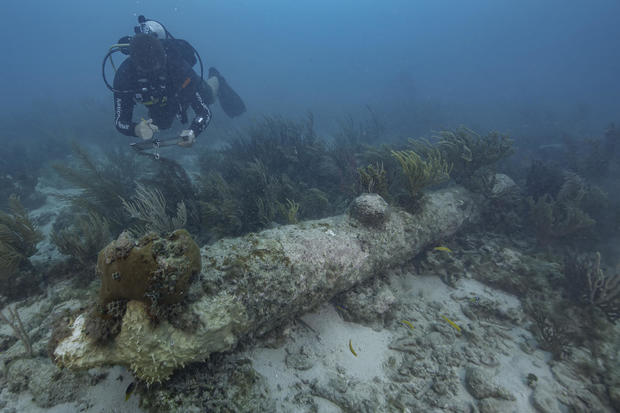
Archeologists in 2021 surveyed the site and found five cannons, weighing between 6 and 9 pounds, about a quarter mile from the main wreck site. Experts were finally able to determine they were indeed cannons thrown overboard when the warship first ran aground. Based on this, archaeologists have concluded the wreck first located in 1993 was in fact HMS Tyger.
"Archeological finds are exciting, but connecting those finds to the historical record helps us tell the stories of the people that came before us and the events they experienced," said Park Manager James Crutchfield. "This particular story is one of perseverance and survival. National parks help to protect these untold stories as they come to light."
About 300 crewmembers were on board HMS Tyger when it wrecked, and the survivors spent 66 days marooned on an island of what is now Garden Key, park officials said.
"The stranded survivors battled heat, mosquitoes and thirst while attempting to escape the deserted island," the park service said.
The crew burned the remains of the warship to make sure its guns did not fall into enemy hands. Ultimately, they built makeshift boats from salvaged pieces of HMS Tyger and "made a 700-mile escape through enemy waters" to Jamaica. The journey took 55 days.
HMS Tyger was the first of three British warships to sink off the Florida Keys, the park service said . Archeologists previously identified the locations for HMS Fowey and HMS Looe.
"This discovery highlights the importance of preservation in place as future generations of archeologists, armed with more advanced technologies and research tools, are able to reexamine sites and make new discoveries," said Josh Marano, the maritime archeologist who led the team that identified HMS Tyger.
The site is already protected under cultural resource laws that apply to Dry Tortugas National Park, but the positive identification of HMS Tyger offers additional protection under the Sunken Military Craft Act of 2004, officials said. The remains of HMS Tyger and its artifacts remain the property of the British government.
Park officials say shipwrecks at Dry Tortugas face a variety of natural and himan threats, including major storms, erosion, illegal excavation, theft, vandalism, and physical damage from surface activities.
"The public plays an important role in helping the National Park Service to preserve and protect HMS Tyger and other submerged archeological resources for this and future generations," the service said.
The archaeologists' findings were recently published in the International Journal of Nautical Archaeology.

Stephen Smith is a senior editor for CBSNews.com.
More from CBS News

Officer reportedly beheaded, her 2 bodyguards killed in Mexico

An Alabama sculpture park evokes the painful history of slavery

Jacksonville Beach shootings leave 1 dead, 3 wounded

Dr. Dre says he had 3 strokes while in hospital for brain aneurysm
- Skip to global NPS navigation
- Skip to the main content
- Skip to the footer section

Exiting nps.gov
Rediscovering hms tyger.
On January 13, 1742 HMS Tyger ran aground on coral reefs near Garden Key. The crew desperately heaved the heavy cannon and anchors offboard to lighten the load, and tried various means to shift the vessel off its perch. But it was no use. HMS Tyger was stuck – really stuck – and friends were 700 miles away. Hundreds of years later, archeologists identified the shipwreck and have learned much more about the crew’s plight on the isolated island chain.
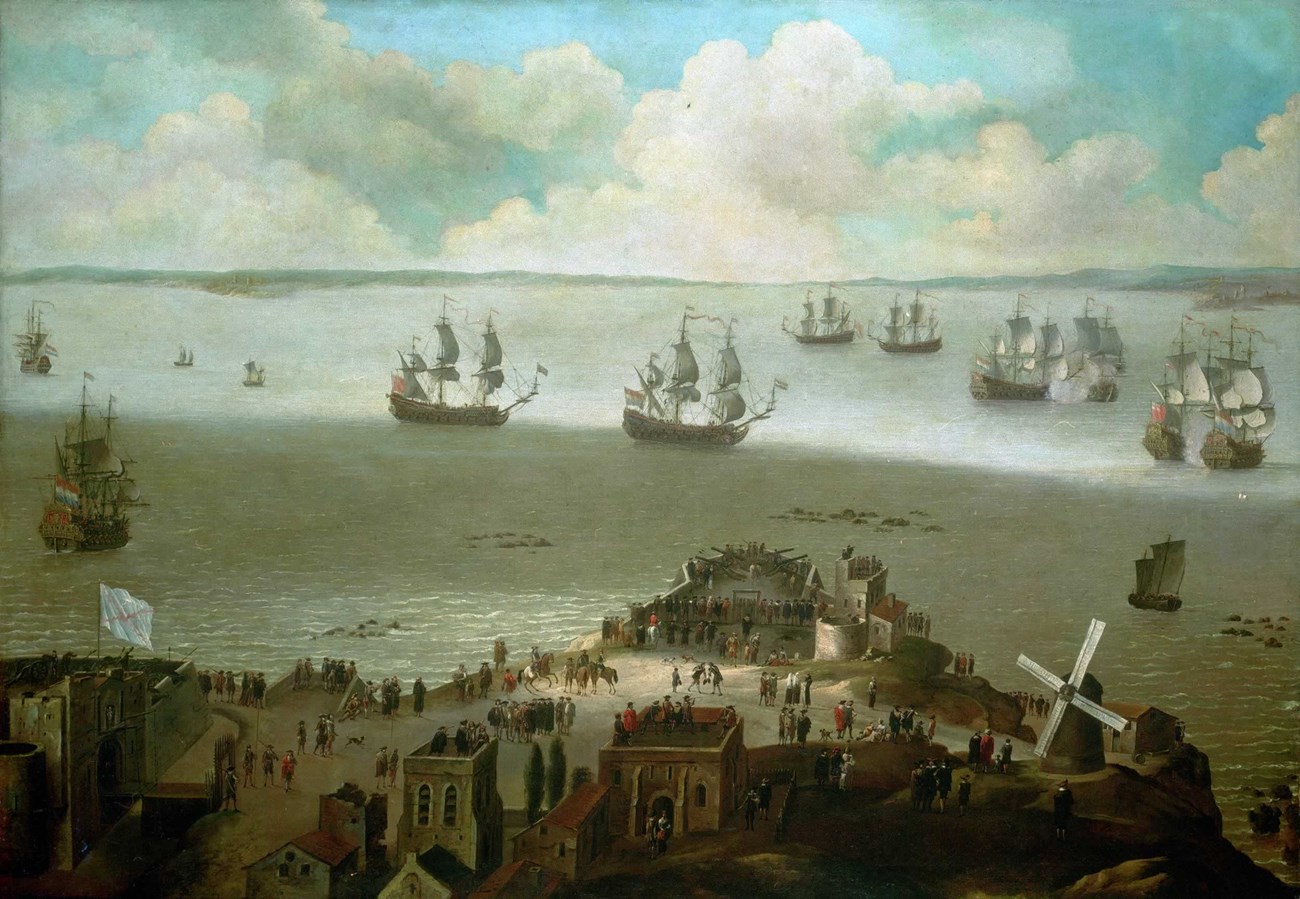
History of HMS Tyger
British ships arrived in the Florida Keys during the Anglo-Spanish War, also known as the War of Jenkins’ Ear. HMS Tyger was a British warship built in 1647, then reconfigured several times. In 1741, Tyger measured 130 feet long and weighed 704 tons. It carried six 6-pounders on the quarter deck, twenty-two 9-pounders on the upper deck, and twenty-two 18-pounders on the gun deck. Its complement included 281 men, including 5 commissioned officers and 57 marines. The ship and crew sailed in the vicinity of Cuba and Jamaica, intimidating the Spanish as they went, before spotting sails while on patrol between Cape Corrientes and Cape San Antonio. They pursued the Spanish into the Gulf of Mexico, logging but not fully registering the increasingly shallow depths. And then, on January 13th 1742, Tyger ran aground.
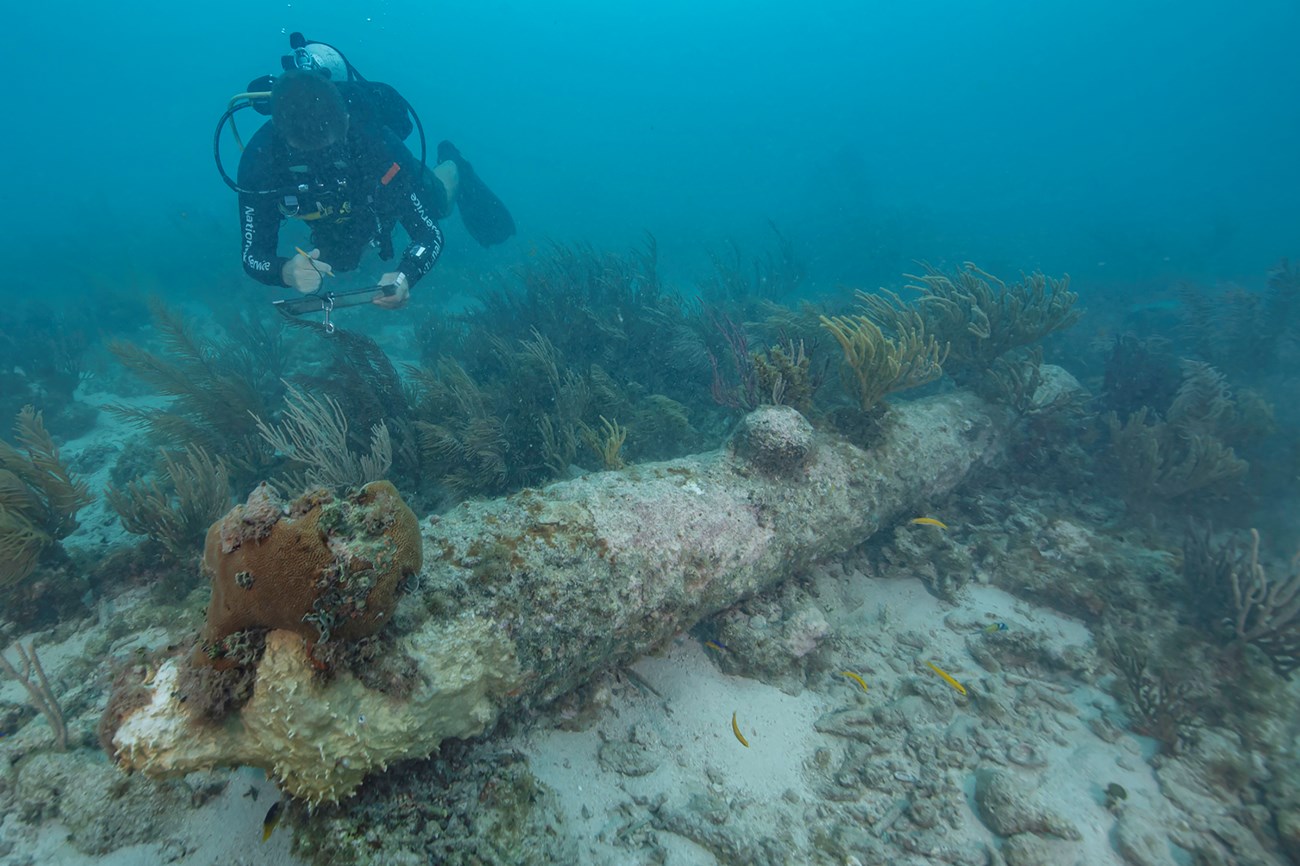
NPS photo by Brett Seymour
Future Stewardship
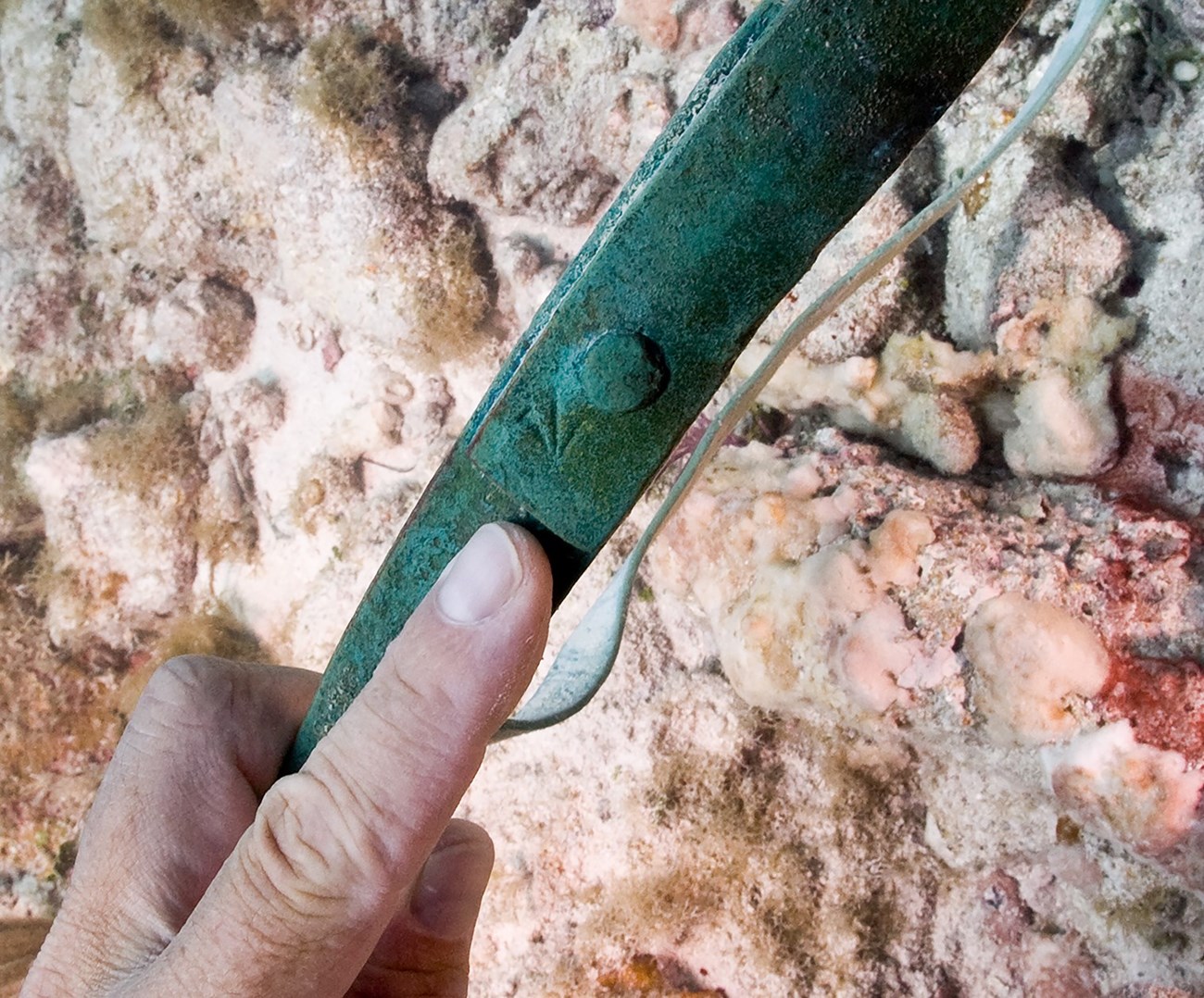
For More Information
You might also like.
- dry tortugas national park
- archaeology
- underwater archeology
- underwater archaeology
- submerged resources
- 18th c history
- 19th century history
- 20th century history
- underwater research
- underwater site
Dry Tortugas National Park
Last updated: March 14, 2024
Panama Says Has No Knowledge of Iranian-Owned Ships on Registry
PANAMA CITY (Reuters) - Panama's maritime authority said on Monday it has no knowledge of ships owned by Iranians being in its registry, following concerns from U.S. authorities on the matter.
The United States asked Panama last week to ban Iranian vessels sanctioned by Washington from using its flag, as officials looked into the possibility that Panamanian-flagged vessels were used to transport Iranian oil.
Panama said it has not received formal requests to cancel registries since 2020.
The Central American country has the largest ship registry in the world, with more than 8,000 vessels sailing with its flag.
War in Israel and Gaza

It provides so-called "flags of convenience" that allow ship owners to register their vessels in a country to which they have no link in exchange for a fee and freedom from oversight.
(Reporting by Elida Moreno; Editing by Sarah Morland)
Copyright 2024 Thomson Reuters .
Join the Conversation
Tags: Panama , Iran , United States , Middle East

Best Countries

Health News Bulletin
Stay informed on the latest news on health and COVID-19 from the editors at U.S. News & World Report.
Sign in to manage your newsletters »
Sign up to receive the latest updates from U.S News & World Report and our trusted partners and sponsors. By clicking submit, you are agreeing to our Terms and Conditions & Privacy Policy .
You May Also Like
The 10 worst presidents.
U.S. News Staff Feb. 23, 2024

Cartoons on President Donald Trump
Feb. 1, 2017, at 1:24 p.m.

Photos: Obama Behind the Scenes
April 8, 2022

Photos: Who Supports Joe Biden?
March 11, 2020

Biden Anxious to Shore Up Swing States
Susan Milligan March 18, 2024

What to Know About the Looming Shutdown
Lauren Camera March 18, 2024

The Week in Cartoons Mar. 18-22
March 18, 2024, at 3:05 p.m.

March Madness: Fed, Budget Spell Upset
Tim Smart March 18, 2024

Trump’s Strategy of Delay Is Working
Lauren Camera March 15, 2024

Judge: Willis Can Stay on Trump Case

Leader of Yemen's Houthis vows to attack more shipping lanes

The Reuters Daily Briefing newsletter provides all the news you need to start your day. Sign up here.
Reporting by Enas Alashray and Ahmed Tolba; Editing by Leslie Adler
Our Standards: The Thomson Reuters Trust Principles. , opens new tab

U.S.'s Blinken to push for Gaza ceasefire on Middle East trip
U. S. Secretary of State Antony Blinken will visit the Middle East this week, aiming to reach a ceasefire agreement between Israel and Hamas, and secure the release of hostages held by the Palestinian militant group.


IMAGES
VIDEO
COMMENTS
USS Independence (LCS-2) is the lead ship of the Independence-class of littoral combat ships.She is the sixth ship of the United States Navy to be named for the concept of independence.The design was produced by the General Dynamics consortium for the Navy's LCS program, and competes with the Lockheed Martin designed Freedom variant.. Independence, delivered to the Navy at the end of 2009, was ...
The Independence class is a class of littoral combat ships built for the United States Navy.. The hull design evolved from a project at Austal to design a high speed, 40-knot-cruise ship. That hull design evolved into the high-speed trimaran ferry HSC Benchijigua Express and the Independence class was then proposed by General Dynamics and Austal as a contender for Navy plans to build a fleet ...
The Littoral Combat Ship is the Navy's newest class of warship. The INDEPENDENCE variant LCS is an aluminum Stabilized Slender Trimaran ship and the FREEDOM variant LCS is a steel Double Chine Advanced Semi-Planing Monohull ship. LCS Background. Navy war games, fleet experiments and analytic studies conducted after the end of the Cold War and ...
The Littoral Combat Ship (LCS) is a class of Small Surface Combatants armed with capabilities focused on defeating global challenges in the littorals. LCS is designed to provide joint force access ...
The Freedom variant. of the U.S. Navy's Littoral Combat Ship (LCS) class is a high-speed, agile, shallow-draft and networked surface ship. The LCS 1 and follow-on ships (LCS 3, LCS 5, LCS 7, etc.) are open-ocean capable, but are designed to defeat growing littoral threats and provide access and dominance in the coastal water battlespace.
In July 2008, Israel requested the foreign military sale (FMS) of up to four vessels of the LCS-1 variant. "The littoral combat ship (LCS) is the first of a new family of surface ships for the US Navy.". USS Freedom (LCS-1) is the first in the Lockheed Martin Freedom-class of littoral combat ships. Lockheed Martin proposed the Freedom-class ...
The U.S. trimaran USS Independence USS Freedom on sea trials in February 2013 before her first deployment. A littoral combat ship (LCS) is either of two classes of relatively small surface vessels designed for near-shore operations by the United States Navy.It was "envisioned to be a networked, agile, stealthy surface combatant capable of defeating anti-access and asymmetric threats in the ...
Navy Keeps Expanding Littoral Combat Ship Missions Even as Both Classes Shrink. USS Charleston (LCS-18) transits the South China Sea at full power on Jan. 22, 2023. US Navy Photo. The challenge to ...
Retaining a couple of dozen LCSs through the 2030s and 2040s should help the fleet jumpstart its long-stalled plan to grow from today's 290 front-line warships to 350 ships in two decades or so.
USS 'Independence,' USS 'Manchester' and USS 'Tulsa' sail in formation in the eastern Pacific. The U.S. Navy has confirmed it will decommission the first two Littoral Combat Ships, likely ...
Impossible Engineering | Thursdays at 9/8cThe new Littoral Combat Ships like the USS Independence use a trimaran design for greater speed, agility, and stabi...
The 3,000-ton Independence and sister-ship USS Coronado (LCS-4) were the first two Independence-class trimaran ships built to compete for the Navy's Littoral Combat Ship contract.
The Naval Group Class-04-03 4,000-ton "Ocean Avenger" trimaran Drone Carrier Warship ... (LHD) can deploy as a standard light aircraft carrier (standard is six United States Marine Corps (USMC) F-35Bs on board), or as a "Lightning Carrier," equipped with anywhere from 10 to 20+ F-35Bs as part of an Amphibious Ready Group. However, China ...
The US Navy's Littoral Combat Ship (LCS) programme described a new naval dawn at its outset, offering a two-variant class of warship intended to operate in the seas and oceanic littorals, a smaller vessel for presence, interdiction, and maritime security operations where an Arleigh Burke-class destroyer might be considered overkill.. With the twin designs in a single LCS 'class', the ...
by Chris Jennewein May 22, 2023. The future USS Canberra departs San Diego Harbor for an exercise in April. Navy photo. A littoral combat ship bound for Naval Base San Diego will be commissioned ...
In 2017, the Office of Naval research awarded Leidos a $35.5 million contract to build the 145-ton trimaran as a follow-up to the original Leidos Sea Hunter that was developed by DARPA as a high ...
The Triton trimaran research ship was a technology demonstrator ship for the Royal Navy's future surface combatant (FSC) frigate requirement, due to enter service from 2013 and replace the Type 23 frigates. Triton is the world's largest motor powered trimaran (triple-hulled) vessel, with a length of 90m and beam of 22m.
The company then started building Littoral Combat Ships (LCS) for the US Navy, based on the same trimaran design. And, now, Austal is launching an even more refined version that improves sea ...
USS John L. Canley joined the active fleet as the US Navy's newest warship, a floating sea base. The Canley is the Navy's sixth expeditionary mobile base (ESB). The first of its name, the warship ...
A TRIMARAN warship, with three narrow hulls, would need only half the power of conventional vessels to achieve the same top speed, according to its British designers. Vosper Thornycroft, a ...
The paper commences with a resume of the origins of the Trimaran concept, its first power boat example, the Ilan Voyager, and the Advanced Technology Frigate design which adapted the trimaran configuration to a modern warship requirement. The other UCL design studies, ranging from an offshore patrol vessel to a small aircraft carrier, are outlined.
If the ships are actually useful, the fleet might be able to justify keeping them for their full 25-year planned service lives instead of prematurely sending them to the breakers. ... The post The US Navy's hi-tech war trimarans are finally going up against China appeared first on The Telegraph. Share 218 Tweet 137 Share. Trending Posts. Far ...
U.S. officials said that a temporary port, built from ships and then moved close to shore, would allow hundreds of truckloads of aid to reach Gazans on the brink of starvation. By David E. Sanger ...
At 273 feet long with more than 10,000 square feet of deck area, the Besson-class vessels are among the US Army's largest ships. During Logistics Over-the-Shore operations, LSVs can carry up to ...
Taiwan on Saturday warned off Chinese coast guard ships that entered its restricted waters near frontline islands close to China for a second day in a row, as tensions simmer across the sensitive ...
Florida treasure hunters find 300-year-old coins 01:00. A British warship has been identified off the Florida coast nearly three centuries after it sank while on patrol in the waters of what is ...
US Navy Photo. NAVAL BASE SAN DIEGO, Calif. - A quartet of experimental unmanned surface vessels will set sail for Hawaii this summer for a test of a new unit focused on ramping up the Navy's ...
British ships arrived in the Florida Keys during the Anglo-Spanish War, also known as the War of Jenkins' Ear. HMS Tyger was a British warship built in 1647, then reconfigured several times. In 1741, Tyger measured 130 feet long and weighed 704 tons. It carried six 6-pounders on the quarter deck, twenty-two 9-pounders on the upper deck, and ...
The United States asked Panama last week to ban Iranian vessels sanctioned by Washington from using its flag, as officials looked into the possibility that Panamanian-flagged vessels were used to ...
The leader of Yemen's Houthis, Abdul Malik al-Houthi, said on Thursday the group's operations targeting vessels will escalate to prevent Israel-linked ships from passing through the Indian Ocean ...